The Friendly Whales of Mexico!
In the warm winter waters of Baja California live calves,
cows, and bulls that are in a word large. The calves at birth are almost
3 Meters (15 feet) long. When full grown the bulls are about 12M (40 feet),
and the cows are up to 16 M or about 50 feet and can weigh up to 32,000
kg (70,000 lb., or 35 tons). To give you an idea as to how big a cow is
the next time you see one of those big cross country buses well it's about the
same length as these cows.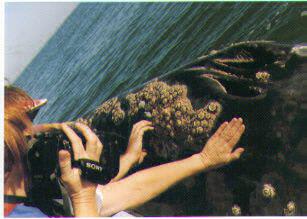 What are we talking about? Paul Bunion's Blue Ox "Babe" and his family?
No! We are talking about the friendly whales of Baja California, Mexico,
the gray whale (Echrichtius Robustus).
What are we talking about? Paul Bunion's Blue Ox "Babe" and his family?
No! We are talking about the friendly whales of Baja California, Mexico,
the gray whale (Echrichtius Robustus).
GENERAL DESCRIPTION
Grays are a mid size whale generally gray in color and are
covered with patches of barnacles and other parasites (whale lice). Patterns
of the barnacles differ from whale to whale and allow positive identification
of individuals. These parasites seem to bother the whales sensitive
skins and whales have been seen apparently trying to rub them off on the
sea floor or against the bottoms of boats or other floating structures.
Breaching may also be an attempt to dislodge these annoyances. Gray whales,
at least in Mexican waters, are surprisingly warm to the touch. There
skin is not a smooth as that of faster cetaceans, like dolphin, because
when the barnacles are finally scraped off a slight indentation is left
in the skin that can be seen as well as felt. The are also short (1 cm
or so in length) thick hairs (a few mm) along the upper lip of some
individuals. In place of the dorsal (top) fin are a number of bumps or
knuckles running along the back, starting a bit past half way and extending
towards the tail. The head of the gray whale is also some what narrow.
From my observations of the whales in Laguna San Ignacio it can be deduced
that the head and front flippers are use for directional control, and the
tail is used for propulsion. That tail is about 5 M or 16 feet wide and
is said to generate about 500 horse power.
COWS AND CALVES
Most gray whales are born in the shallow lagoons in Baja
California. While in the lagoons the Mothers teach there calves how to
swim! YES that is right. The mothers must TEACH the calves how to swim,
supporting them for the first few days of life. The calfs instinctually
know to breath when there blowhole is out of the water and close it when
it is not. 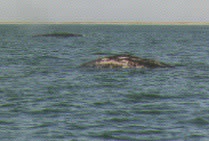 While
in the lagoons the mothers take the calves to the mouth of the lagoons
and have them swim against the tides when it changes. Mother and calf are
also seen swimming laps to help get the babies in shape for there long
swim to summer Arctic feeding grounds.
While
in the lagoons the mothers take the calves to the mouth of the lagoons
and have them swim against the tides when it changes. Mother and calf are
also seen swimming laps to help get the babies in shape for there long
swim to summer Arctic feeding grounds.
The baby calves are about 5 M (15 feet) long at birth
and weigh about a ton, or perhaps a bit more - about the size of
a small car. The calves drink milk that is 55% fat. The "normal" milk you
have on your kitchen table is less than 4% fat! On this diet the baby whales
gain about 50 Kg (150 Lbs) a day!
MIGRATION and FEEDING
While gray whales winter, give birth, and mate in Baja they
then make the longest migration know of any mammal. Swimming along the
North American coastline at about 5 kph (3 mph) from the warm waters of
Baja to the cold waters of the Bering and Chukchi seas off Alaska, a one
way trip of about 9,700 km (6,000 mi). There the gray whales feed
on small tube worms living on the bottom, about 120 m (395 ft) in depth.
From the time the whales left the previous fall (November) the adults have
not eaten anything until arriving in there arctic feeding grounds in the
spring (April). Now the grays start foraging along the sea floor. Turning
on there side the whales gulp huge mouthfuls of silt, and using there tongue
strain the mud and water through there baleen leaving small tube worms
and small crustaceans behind to be swallowed. It is now known that the
grays will feed on small fish and mysids while migrating given the opportunity.Follows is a
picture from the book WHALES by Seymour Simon, published by Scholastic
(0-439-06237-3). The picture shows a gray whale actually feeding on the bottom,
as you can see the whale is feeding from the side of his(or her) mouth.

SPECIALIZATION AND CLASSIFICATION
The 130- 180 baleen plates in the whales upper jaw are shorter
than any other baleen whales, and only two, or rarely 3 or 4, pleats are
present to allow for expansion of the lower mouth. The small number
of mouth groves, short baleen, lack of a dorsal fin, slow swimming speed,
"unusual" bottom feeding style, and giving birth in the Mexican lagoons
has left a split in the scientific community. Some think that grays are
close to the original whale stock, others see these as specialization making
Grays an advanced whale type. I guess only the whales and the maker know
for sure.
Grays are classified as follows:
-
Kingdom: Animalia - There animals as opposed to plants
or fungi, or bacteria.
-
Phylum: Chordata - Have a Notchcords / dorsal nerve
cord and gill slits at some point in the animals life. (For example we
humans only have gill slits in the womb).
-
Subphylum: Vertebrata - Has a vertebral column (backbone).
-
Class: Mammalia - Has Hair, is Endothermic (warm blooded)
and gives Milk. Not all mammals have live births (2 lay eggs) ... but all
female mammals can nurture there young with milk. Whale milk is about 55%
fat by the way! Cow milk is a bit more than 4% (in the carton 3.5% or less)!
-
Order: Cetacea - Whales, dolphins, and Porpoises.
Cetacea live in ALL seas of the world and some large rivers. General characteristics
of the order Cetacea are:
-
Horizontal Tail Flukes
-
Front limbs modified into paddle shaped flippers
-
No external digits or claws on front flippers
-
No External hind limbs
-
Sparse Bristles of hair...on head. May be absent in mature
individuals.
-
Blubber layer
-
Nostrils that open on the highest point on head to a single
or double blowhole.
-
No external Ears (Grays have an internal ear wax plug that
shows annual growth rings)
-
Reduced or absent sense of smell. Extremely well developed
hearing.
-
Suborder: Mysticeti - Baleen whales. In addition to
Baleen, this order has paired blowholes. Odontoceti or "toothed" whales
have a single blow hole.
-
Family: Eschrichtidea
-
Subfamily: Agaphelinae
-
Genus: Eschrichtius
-
Subgenus: robustus
Dealings with Man
Gray whales are also called "Devil Fish" because of the love
the mothers show for there calves. This sounds strange but let me explain.
When man was hunting the Grays almost to extinction - twice - whalers found
for them a gold mine in the shallow lagoons in Baja California. The whalers
would harpoon the baby whales to get at the large mother whales!
The mothers would "charge" the whalers trying to save her calf and would
then be killed as well. Whalers did hunt the Gray Whales that used to live
along the Asian coast to extinction. Fortunately in 1946 gray whales
became legally protected and have increased to over 21,000 souls. With
the number of whales approaching what is thought to be there historical
numbers [along the North American coast] the whales have been removed from
the Endangered Species List, but are still protected by the International
Convention for the Regulation of Whaling, the International Whaling Commission,
and by the Marine Protection Act of 1972.
However...The United States has allowed the Makah Indian
Nation to kill 5 and maim 5 gray whales. The Russians have also gotten
into the act and are slaughtering Gray Whales as well!
We have taught Grays to befriend mankind. It is immoral
to kill them! We are NOT just talking about a few whales as Vice President
Gore has stated. The problems are that the United States went around the
International Whaling Commission, so now other "historical" whaling nations,
like Japan and Norway want to start whaling as well!
Write to the IWC, the
President, the United Nations (It
might help), you local paper, or even the Makah
Nation!
Support any or all of the following. The following
groups to my knowledge are Actively, and PEACEABLY involved in AntiWhaling
activities.
The Makah have ATTACKED the peaceful demonstrators and
stolen there property (A Zodiac Rubber boat). Using slingshots the
Makah have attacked with rocks, ball bearings, and even fish hooks!
When I think of interactions between Grays and Humans
... I'd rather not think of the above. Rather the following!
A Whale spraying us for fun ... 
...another posing for a picture!

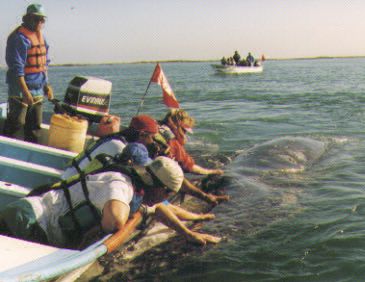 Rubbing a whale. That mouth
is about as along as the ponga almost 5 meters (14 feet)!
Rubbing a whale. That mouth
is about as along as the ponga almost 5 meters (14 feet)!
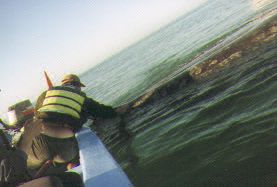 Scratching
Scratching
Patting a whale on the snout ... look at all the barnacles!
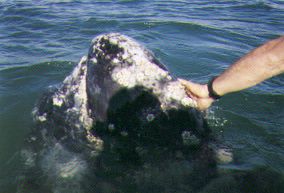
Some Gray Whale Behaviors.
Swim:
Gray whales cruise at about 3 or 4 knots, it is this slow
speed that makes it possible for the barnacles and lice to stay attached.
A Gray can maintain a speed of 10 knots for about an hour. Top speed is
obtained while breaching and as been calculated to be over 30 knots.
Whales swim by moving there tails up and down. Fish move from side to side.
Spout or Blow: 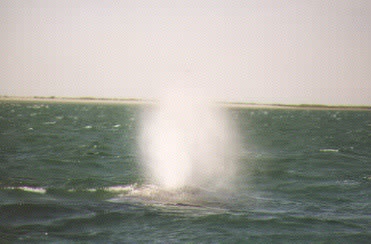
Whale spout is really just what happens when the whale exhales.
Gray Whales, like all whales, are mammals and breathe air. When the warm
moist air from inside the whale leaves the blowhole on the top it condenses
and you can see the spout! Baleen whales have a divided blow hole,
kind of like your nose. From the front or rear the spout has a thin heart
shaped look to it and is 2 or 3 meters high (6-10 feet). Toothed whales
only have a single blow hole. Different species of cetaceans can be discerned
by there spouts more or less.
Spy Hop:
Spy Hopping is where the whale sticks his (or her) head out
above the water for a look around. Some times this is just a quick up and
down motion, other times the whales may leave there heads above the water
for extended times. 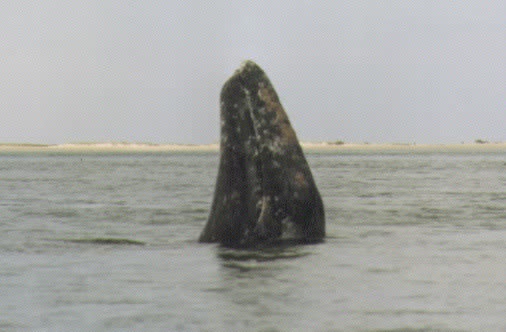 In
shallow waters the whales may actually be "standing" with there tail flukes
on the sea floor. Spy hoping may be an aid in navigation, or perhaps the
whale just wants to see something on the surface. Whales see quite well
both above water and below. There eyes contain powerful muscles that change
the shape of the lens to allow it to focus both below and above the surface.
In
shallow waters the whales may actually be "standing" with there tail flukes
on the sea floor. Spy hoping may be an aid in navigation, or perhaps the
whale just wants to see something on the surface. Whales see quite well
both above water and below. There eyes contain powerful muscles that change
the shape of the lens to allow it to focus both below and above the surface.
Sounding:
Whales will generally take a few short breaths and then dive
deep for a number of minutes. Grays can stay submerged for over 8 minutes
and dive to deeper than 150 Meters (500 feet). Before slipping totally
underwater the tail or fluke is shown. 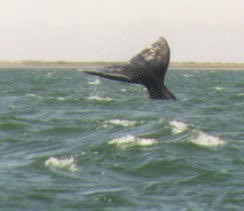
Breaching:
Breaching is where a whale propels much of there body
out of the water. I have seen whale do this 11 or 12 times in a row. I
might be a man whale showing off to the lady whales, it might be to dislodge
lice and barnacles, or it might just be whales having a good time.


New Feature ... VIDEO (QuickTime3 Format)
Close up of whale swimming by on the side(Mexico 1998)[1.1MB]
Gray Whale going South (USA 1998)[1.7 MB]
Same Gray Whale swimming south (USA 1998) [4.5 MB]
The following VIDEO are in QuickTime4 Format
Close up of whale swimming by (Mexico 1999)[1.1MB]
Cow and Calf (Mexico 1999)[1.2 MB]
Jim eating a taco (Mexico 1999) [1.5 MB]
See who went last year (1999) - from the MOOvie [3.5 MB]
Be sure to say what it's about (i. e. ... the gray whale page)
Last Update: 30-May-2011 CE




 What are we talking about? Paul Bunion's Blue Ox "Babe" and his family?
No! We are talking about the friendly whales of Baja California, Mexico,
the gray whale (Echrichtius Robustus).
What are we talking about? Paul Bunion's Blue Ox "Babe" and his family?
No! We are talking about the friendly whales of Baja California, Mexico,
the gray whale (Echrichtius Robustus).
 While
in the lagoons the mothers take the calves to the mouth of the lagoons
and have them swim against the tides when it changes. Mother and calf are
also seen swimming laps to help get the babies in shape for there long
swim to summer Arctic feeding grounds.
While
in the lagoons the mothers take the calves to the mouth of the lagoons
and have them swim against the tides when it changes. Mother and calf are
also seen swimming laps to help get the babies in shape for there long
swim to summer Arctic feeding grounds.



 Rubbing a whale. That mouth
is about as along as the ponga almost 5 meters (14 feet)!
Rubbing a whale. That mouth
is about as along as the ponga almost 5 meters (14 feet)!








